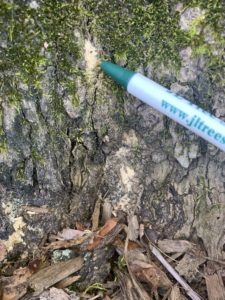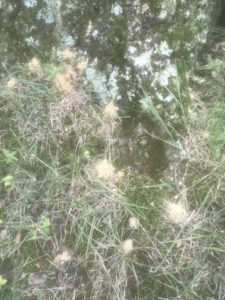Why are my trees struggling this year?
It’s hard to argue that the most destructive pest to landscape trees and plants in our region this past year was the ambrosia beetle. Many large trees have been lost to the ambrosia beetle, and it will continue to dominate in this region until natural competition catches up or all the trees are dead! I’m betting on the former. Let’s take a closer look at the pest.
Ambrosia beetles are not a particular species but actually a group of closely related beetles in the weevil family. Until recently little was known about them, but they are quickly becoming very well known for their destructive behavior. They are a non-host specific pest, meaning that they will attack almost any type of plant. Despite this, there are certainly plants that are more susceptible than others for various reasons. We are noticing white oaks and chestnut oaks seem to be a favorite. Typically they attack the lower six feet of the stem to just below the surface of the ground. Tell-tale signs include rapid die-back in the canopy (even large trees can decline in a matter of weeks) and “frass piles” on the ridges of the bark at the lower stem. The frass can look like tubes sticking out of the tree, or like piles of clean, fine sawdust piled up at the entry points. The entry points themselves are very small and difficult to locate.
A Secondary Problem
Now that we know a little bit about the pest, let’s discuss the best ways to keep your trees from being killed by ambosia beetles. It would seem that the best thing to fight an insect with would be an insecticide. However, the “plant health care” approach would focus on creating and maintaining an environment that would lend itself to healthier plants in general. In fact, it should be known that ambrosia beetles are a “secondary pest,” meaning that they typically do not attack perfectly healthy, unstressed trees. It is much more common to see a tree that is already under some type of stress be attacked by ambrosia beetles. That stress can come from many different sources and every situation is unique. Some typical factors can be construction damage, drought, nutrient variances, weather, pollution, other pests and diseases, and more. Going further, many large trees actually release pheromones when under stress that attract ambrosia beetles and other wood boring insects.
How to keep your trees safe?
So, how do you keep your trees safe? The best thing you can do is to keep your tree happy and healthy to begin with. I am finding that in our region, a common source of the original stress to the trees has been too much water. Here in the northeast, we have had excessive rainfall each spring for 2 years in a row. Too much water can be a problem for plants and trees. Tree roots that are sitting in saturated soils for too long are deprived of necessary gas exchange and will incur diseases like Phytophthora root rot and ultimately die back. Particularly if your trees are in low lying areas that commonly hold water after rainfall, a mitigation plan might be necessary. That plan might involve adding drains, fungicide application, or even changing the topography or soil composition to allow for better drainage.
The moral of the story is this: It is of vital importance now more than ever, if you care about your trees or what is under them, to have them inspected by a competent arborist. We are able to look at a tree and determine if there are deficiencies or defects that could be problematic for the future of the plant and property.
Written by Nicholas Shively, MA-5872A
11/17/2019
to learn more, visit the TCIA website and search Ambrosia Beetle and more on other tree care related topics click here.

